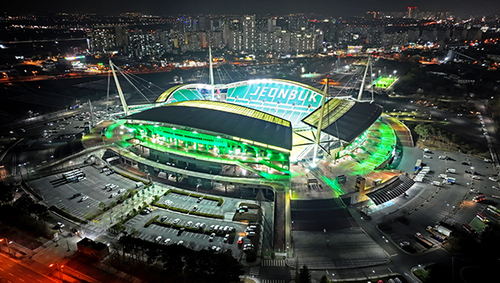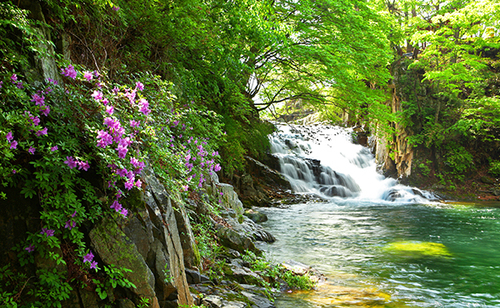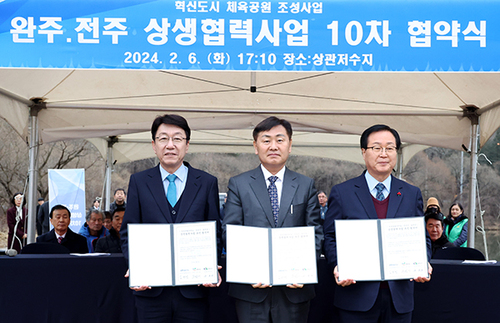| в–І 29мқј мҳӨм „ 6мӢңлҘј кё°мӨҖмңјлЎң м „л¶Ғ 14к°ң м „ м§Җм—ӯм—җм„ң лҜём„ёлЁјм§Җ(PM10) лҶҚлҸ„к°Җ 2мӢңк°„ мқҙмғҒ 300гҺҚ/гҺҘмқ„ мҙҲкіјн•Ём—җ л”°лқј, нҷ©мӮ¬ мң„кё°кІҪліҙ 'мЈјмқҳ' лӢЁкі„к°Җ л°ңл №лҸј кұҙк°•кҙҖлҰ¬м—җ к°Ғлі„н•ң мЈјмқҳк°Җ мҡ”л§қлҗңлӢӨ. (кі лҶҚлҸ„ лҜём„ёлЁјм§Җ 7к°Җм§Җ н–үлҸҷмҡ”л №) / лҸ„н‘ңм ңкіө = м „л¶ҒлҸ„мІӯ лҜём„ёлЁјм§ҖлҢҖмқ‘нҢҖ © к№Җнҳ„мў… кё°мһҗ |
|
29мқј мҳӨм „ 6мӢңлҘј кё°мӨҖмңјлЎң м „л¶Ғ 14к°ң м „ м§Җм—ӯм—җм„ң лҜём„ёлЁјм§Җ(PM10) лҶҚлҸ„к°Җ 2мӢңк°„ мқҙмғҒ 300гҺҚ/гҺҘмқ„ мҙҲкіјн•Ём—җ л”°лқј, нҷ©мӮ¬ мң„кё°кІҪліҙ 'мЈјмқҳ' лӢЁкі„к°Җ л°ңл №лҸј кұҙк°•кҙҖлҰ¬м—җ к°Ғлі„н•ң мЈјмқҳк°Җ мҡ”л§қлҗңлӢӨ.
м „л¶ҒлҸ„лҠ” "м§ҖлӮң 26мқјл¶Җн„° лӘҪкіЁ кі л№„мӮ¬л§үкіј мӨ‘көӯ лӮҙлӘҪкіЁкі мӣҗм—җм„ң л°ңмӣҗн•ң мҳҒн–ҘмңјлЎң м „көӯ лҢҖл¶Җ분 м§Җм—ӯмқҙ нҷ©мӮ¬ мҳҒн–Ҙк¶Ңм—җ л“Өл©ҙм„ң кө°мӮ°гҶҚм •мқҚгҶҚк№Җм ңгҶҚкі м°ҪгҶҚл¶Җм•Ҳ л“ұ м„ңл¶Җк¶Ңкіј м „мЈјгҶҚмқөмӮ°гҶҚмҷ„мЈј л“ұ мӨ‘л¶Җк¶Ң л°Ҹ лҸҷл¶Җк¶Ңмқё лӮЁмӣҗгҶҚ진м•ҲгҶҚл¬ҙмЈјгҶҚмһҘмҲҳгҶҚмһ„мӢӨгҶҚмҲңм°Ҫ м§Җм—ӯм—җ к°Ғк°Ғ 333гҶҚ396гҶҚ252гҺҚ/гҺҘ л“ұ PM-10 лҶҚлҸ„к°Җ мғҒмҠ№н•ҳкі мһҲлӢӨ"кі 29мқј л°қнҳ”лӢӨ.
нҠ№нһҲ, нҷ©мӮ¬ лҢҖмқ‘ л§Өлүҙм–јм—җ л”°лқј нҷ©мӮ¬мў…н•©мғҒнҷ©мӢӨмқ„ м„Өм№ҳн•ҳкі л№„мғҒк·јл¬ҙм—җ лҸҢмһ…н•ҳлҠ” лҸҷмӢңм—җ 'лҢҖкё°нҷҳкІҪліҙм „лІ•'м—җ л”°лқј нҷ©мӮ¬ мң„кё°лҢҖмқ‘ 'мЈјмқҳ' лӢЁкі„лҘј л°ңл №н•ҳкі мһ¬лӮңл¬ёмһҗлҘј л°ңмҶЎн–ҲлӢӨ.
лҜём„ёлЁјм§Җ лҶҚлҸ„к°Җ лҶ’мқ„ кІҪмҡ°, м–ҙлҰ°мқҙгҶҚл…ём•ҪмһҗгҶҚнҳёнқЎкё°гҶҚмӢ¬мһҘ м§Ҳнҷҳмһҗ к°ҷмқҖ лҜјк°җкө°мқҖ л¬јлЎ мқјл°ҳмқёлҸ„ мӢӨмҷёнҷңлҸҷмқҙлӮҳ кіјкІ©н•ң мҡҙлҸҷмқ„ мһҗм ңн•ҙм•ј н•ңлӢӨ.
кұҙк°•н•ң м„ұмқёлҸ„ мҷём¶ң л°Ҹ м•јмҷёнҷңлҸҷмқ„ к°Җкёүм Ғ мһҗм ңн•ҳкі л¶Җл“қмқҙн•ҳкІҢ м•јмҷё нҷңлҸҷмқ„ н• кІҪмҡ° мқјл°ҳ л§ҲмҠӨнҒ¬ лҢҖмӢ KF94 лҳҗлҠ” KF80 ліҙкұҙмҡ© л§ҲмҠӨнҒ¬ лҳҗлҠ” ліҙнҳём•ҲкІҪмқ„ л°ҳл“ңмӢң м°©мҡ©н•ҳлҠ” л“ұ м°Ёлҹүмҡҙн–ү м—ӯмӢң мһҗм ңн•ҙм•ј н•ңлӢӨ.
н•ҷкөҗ мӢӨмҷёмҲҳм—… л°Ҹ м•јмҷёнҷңлҸҷ кёҲм§ҖмЎ°м№ҳлҸ„ лӮҙл ӨмЎҢлӢӨ.
н•ңнҺё, мқҙлӮ мҳӨм „ 9мӢң кё°мӨҖ нҸүк· лҜём„ёлЁјм§Җ(PM10) лҶҚлҸ„лҠ” кө°мӮ° 816гҺҚ/гҺҘ л“ұ м „көӯм—җ кұёміҗ лҜём„ёлЁјм§Җ лҶҚлҸ„к°Җ л§Өмҡ° лҶ’мқҖ мғҒнҷ©мқҙлӢӨ.
'лҜём„ёлЁјм§Җ'лҠ” мҡ°лҰ¬ лҲҲм—җ ліҙмқҙм§Җ м•Ҡмқ„ м •лҸ„лЎң мһ‘мқҖ лЁјм§ҖлЎң мһ…мһҗ нҒ¬кё°м—җ л”°лқј м§ҒкІҪ 10гҺӣ мқҙн•ҳ(10гҺӣмқҖ 0.001гҺқ)мқё кІғмқ„ лҜём„ёлЁјм§Җ(PM10)лқјкі н•ңлӢӨ.
м§ҒкІҪ 2.5гҺӣ мқҙн•ҳмқё кІғмқ„ 'мҙҲлҜём„ёлЁјм§Җ(PM2.5)'лЎң м§Җм№ӯлҗңлӢӨ.
мқҙл“Ө лЁјм§ҖлҠ” л§Өмҡ° мһ‘м•„ мҲЁмқ„ мүҙ л•Ң нҸҗнҸ¬ лҒқк№Ңм§Җ л“Өм–ҙмҷҖ л°”лЎң нҳҲкҙҖмңјлЎң л“Өм–ҙк°Ҳ мҲҳ мһҲмңјл©° лҙ„мІ мқё 3мӣ”мқҖ нҶөмғҒ 'мҙҲлҜём„ёлЁјм§Җ(PM2.5)' лҶҚлҸ„к°Җ м—°мӨ‘ к°ҖмһҘ лҶ’м•„ кұҙк°•кҙҖлҰ¬м—җ к°Ғлі„нһҲ мЈјмқҳн•ҙм•ј н•ңлӢӨ.
нҷ©мӮ¬лЎң мқён•ң лҜём„ёлЁјм§Җ 'л§Өмҡ° лӮҳмҒЁ(мқјнҸүк· PM10 150гҺҚ/гҺҘ мҙҲкіј)' мҳҲліҙ мӢңм—җлҠ” 'кҙҖмӢ¬' лӢЁкі„к°Җ л°ңл №лҗҳкі мӢңк°„лӢ№ нҸүк· лҶҚлҸ„к°Җ 300гҺҚ/гҺҘмқҙмғҒ 2мӢңк°„ м§ҖмҶҚлҗ кІҪмҡ° 'кІҪліҙ'к°Җ л°ңл №лҗҳкі нҷ©мӮ¬м—җ мқҳн•ң лҢҖк·ңлӘЁ мһ¬лӮңмқҙ л°ңмғқн• к°ҖлҠҘм„ұмқҙ лҶ’мқ„ л•ҢлҠ” 'мЈјмқҳ' лӢЁкі„к°Җ лӮҙл Ө진лӢӨ.
PM10 мӢңк°„лӢ№ нҸүк· лҶҚлҸ„к°Җ 800гҺҚ/гҺҘмқҙмғҒ 2мӢңк°„ м§ҖмҶҚлҗ кІғмңјлЎң мҳҲмғҒлҗ л•ҢлҠ” 'кІҪкі„'гҶҚ2,400гҺҚ/гҺҘмқҙмғҒмқҙ 24мӢңк°„ м§ҖмҶҚ нӣ„ 24мӢңк°„ м§ҖмҶҚ мҳҲмғҒ лҳҗлҠ” лҜём„ёлЁјм§Җ(PM10) 1мӢңк°„ нҸүк· лҶҚлҸ„к°Җ 1,600гҺҚ/гҺҘмқҙмғҒмқҙ 24мӢңк°„ м§ҖмҶҚ нӣ„ 48мӢңк°„ м§ҖмҶҚ мҳҲмғҒ мӢңм—җлҠ” 'мӢ¬к°Ғ' лӢЁкі„к°Җ к°Ғк°Ғ л°ңл №лҗңлӢӨ.
вҳһ м•„лһҳлҠ” мң„ кё°мӮ¬лҘј кө¬кёҖ лІҲм—ӯмқҙ лІҲм—ӯн•ң мҳҒл¬ёмқҳ 'м „л¬ё'мқҙлӢӨ.
гҖҗBelow is the 'full text' of an English article translated from the above article with Google Translate.гҖ‘
Jeonbuk issues 'Caution Stage' to warn of yellow dust crisis
As of 6 a.m. on the 29thвҖҰ Exceeding 300гҺҚ/гҺҘ of PM10 in all areas of the province
Reporter Kim Hyun-jong
As of 6 am on the 29th, as the concentration of fine dust (PM10) exceeds 300гҺҚ/гҺҘ in 14 areas in Jeollabuk-do for more than 2 hours, the 'Caution' stage of the yellow dust crisis warning has been issued, requiring special attention to health management. do.
Jeonbuk-do said, "From the 26th of the past, most regions of the country have been affected by the yellow dust due to the influence of the Gobi Desert in Mongolia and the Inner Mongolia Highlands in China. гҶҚThe concentration of PM-10 is increasing in Jinan, Muju, Jangsu, Imsil, and Sunchang, respectively, such as 333, 396, 252гҺҚ/гҺҘ, and so on."
In particular, according to the Yellow Dust Response Manual, a comprehensive yellow dust situation room was installed and emergency work was initiated. At the same time, according to the 'Atmospheric Environment Conservation Act', a'Caution' step was issued to respond to the yellow dust crisis, and a disaster message was sent.
When the concentration of fine dust is high, sensitive groups such as children, the elderly, respiratory and heart disease patients, as well as the general public, should refrain from outdoor activities or excessive exercise.
Healthy adults should refrain from going out and outdoor activities as much as possible, and should also refrain from driving a vehicle, such as wearing a KF94 or KF80 health mask or goggles instead of regular masks if they are unavoidably doing outdoor activities.
School outdoor classes and outdoor activities were also banned.
On the other hand, the average fine dust (PM10) concentration as of 9 am on the day is very high throughout the country, such as 816 гҺҚ/гҺҘ in Gunsan.
'Fine dust' is small enough to be invisible to our eyes, and it is called fine dust (PM10) that has a diameter of 10гҺӣ or less (10гҺӣ is 0.001cm) depending on the particle size.
Those with a diameter of 2.5 Ојm or less are referred to as'ultra-fine dust (PM2.5)'.
These dusts are very small, and when you breathe, they can enter the alveoli and enter the blood vessels immediately. In March, the spring season, the concentration of 'ultra-fine dust (PM2.5)' is usually the highest throughout the year, so you should pay special attention to health care.
In the case of forecasting 'very bad (daily average PM10 exceeds 150гҺҚ/гҺҘ)', the 'interest' stage is issued, and if the average concentration per hour lasts more than 300гҺҚ/гҺҘ for 2 hours, a 'alarm' is issued and When there is a high likelihood of a large-scale disaster caused by a disaster, the 'Caution' step is taken.
When the average concentration per hour of PM10 is expected to last more than 800гҺҚ/гҺҘ for 2 hours, it is expected that more than 2,400гҺҚ/гҺҘ lasts for 24 hours and then continues for 24 hours or the average concentration of fine dust (PM10) is 1,600гҺҚ/гҺҘ When the abnormality is expected to last for 24 hours and then for 48 hours, the 'Severe' stage is issued.




 м»Өл®ӨлӢҲнӢ°
м»Өл®ӨлӢҲнӢ°  н”јн”Ң
н”јн”Ң  лҸ…мһҗнҲ¬кі
лҸ…мһҗнҲ¬кі
















 л§Һмқҙ ліё лүҙмҠӨ
л§Һмқҙ ліё лүҙмҠӨ











